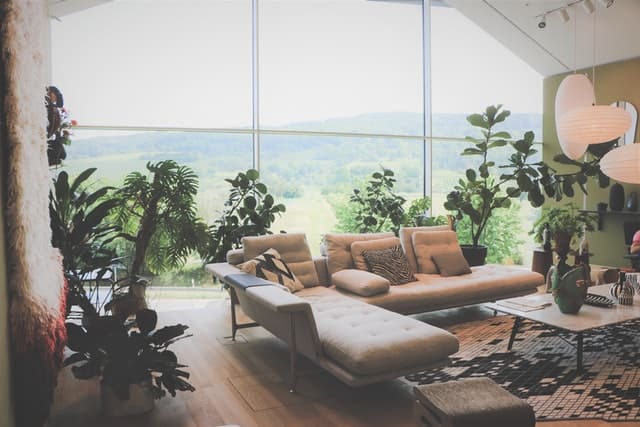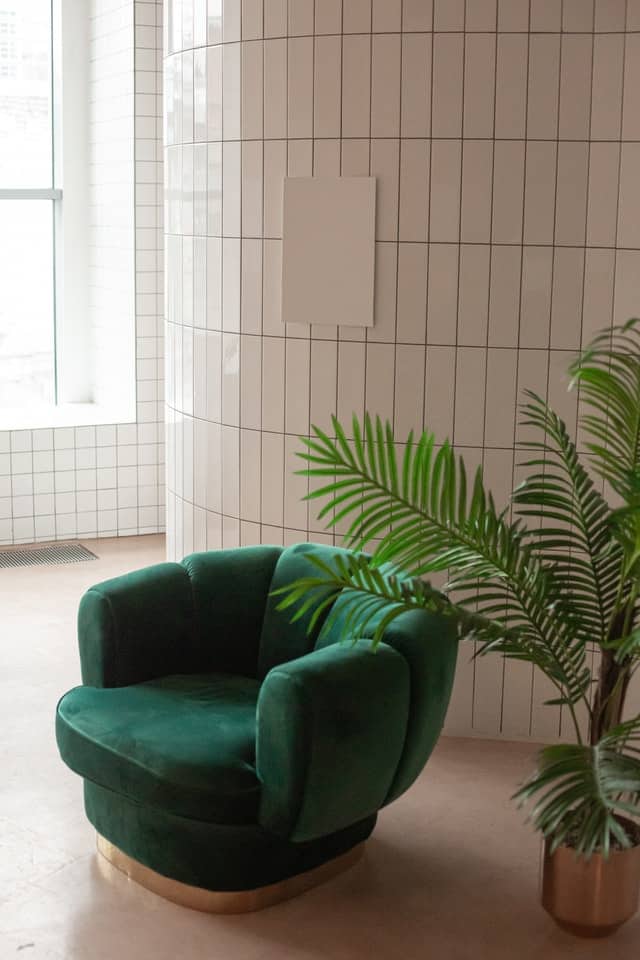One of the most exciting interior design trends in recent years is biophilic interior design, and it’s trending green for a whole other reason! This interior trend not only breathes life into spaces, but it’s a design concept that we can learn a lot from for our own personal spaces at home.
Biophilic interior design is all about bringing the outdoors in, using greenery and natural materials and plants to create spaces that gives you a feeling of being in nature.

So What’s the Biophilic Design Concept?
According to the NRDC (Natural Resources Defense Council) the term biophilia can be described as “the innate human instinct to connect with nature and other living beings.” In the biophilic design concept we see this practice of creating spaces that marries the human connection to and these nature inspired built environments to promote well-being.
In fact, studies have shown that there are many benefits of biophilic design in our homes and other spaces. Some of these health benefits include reducing stress, boosting creativity and productivity as well as increasing a sense of calm and well-being.
The idea of incorporating biophilic design elements into an interior space is not only catching on because of the increased benefits on our health and well-being, but it’s also good for the environment. By using sustainable materials and practices, we can create restorative spaces that are both beautiful and eco-friendly too. In fact it isn’t only residential interior design that incorporates biophilic design, restaurants and hotels have been doing it too!
Here are three major biophilic design principles to follow according to ANS Global and Terrapin Bright Green:
- Bring nature in by including natural elements such as fresh air, plants, and other natural elements.
- Create spaces that give a feeling of being in nature such as tranquility, openness and well-being using.
- Utilize objects, materials, colors, organic shapes, forms and patterns that evoke feelings of the natural world.

Tips for bringing biophilic interior design elements into your home and interior decor:
- Make nature visible in your space. Whether it’s by rearranging your furniture in a way that is in view of nature like trees or a garden or whether it’s creating an indoor garden in your home. Allow your plant life’s natural beauty to be on display. Indulge in green in one way or another.
- Allow light and air to flow through your space in a way that resembles the natural world. Natural light is essential for both the environment and the mind, according to Garden Streets. Open windows and doors are excellent for allowing air circulation and light. You may also using lighting design such as diffused light through sheer curtains.
- Creating a feeling of openness and refuge is key. Basking in the sun, feeling wind on your skin, and the scent of pine trees are all connected to the emotions evoked by nature. On the other side, while nature may provide a sense of openness, it can also provide a sense of security and refuge.
- Bring water into the mix. Water is the lifeblood of nature since it is essential for survival. You can realize this in a variety of ways by mimicking natural sounds such as sounds of the sea or rain. Imagery may also be used to incorporate water into your space.
- Use natural materials, shapes and patterns that remind us of nature. Incorporate materials like stone, wood, and water into your space. Also, consider using furniture and decor with organic shapes that are in harmony with nature. Patterns can also be used to create a feeling of being in nature.

A Few Things You Can Do To Incorporate Biophilic Design At Home:
Paint Your Space The Colour Of Nature
Light and color are important elements of biophilic design, as they can create a sense of openness and well-being to the interior space. To create a biophilic design at home you can start with choosing a color scheme for your walls that are in a more natural colour palette. Opt for light and airy colors such as white, cream, beige, or light green. These colors will help to create a sense of spaciousness in your space. You can also use earth tones to create a more serene space. Calming colors reduces stress and promote a more relaxed feeling in your space.
If you want something a little more vibrant, you can choose colors that mimic nature, such that is found in various shades of green colour. Even shades that are deeper and moodier could work in biophilic interiors. Dark green wall paint or even a greenish blue colour for your walls may be an excellent choice.
We’re seeing lots of green room schemes that really amplify the nature inspired design. Using color as a way to amplify the visual connections between the interior space and the natural environments is powerful. But you don’t have to stick strictly to painting your walls, there are plenty of nature scene wall murals that you can use instead to bring in elements of nature. Contemporary or modern botanical wallpaper and other floral designs are also good alternatives.
Incorporate Natural Materials, Shapes and Patterns
In biophilic interiors everything from the layout of the space to the choice of furniture and accessories make a difference. To bring biophilic design into your home, incorporate natural materials and shapes into your interior design and decor. For example, instead of synthetic carpeting, opt for sisal or wool rugs. Swap out your plastic blinds for some bamboo or wood blinds instead.
To create an interior biophilic design decorating with natural materials is key. Obviously filling your home with plant life is a great first step and the easy way to bring the natural world into your space. And if you’re looking for new furniture, choose pieces made from sustainable materials such as bamboo, wool, or jute. Also opt for furniture and decor accessories that have organic shapes and forms and that are imperfect.
Embrace Biophilic Living
Finally living in a biophilic way doesn’t mean you have to make big changes or live in an eco-friendly home. It’s simply about enjoying the benefits of nature and experiencing the sensory stimuli that comes with it. It can be as simple as adding a few houseplants to your space or opening up your windows to let in some fresh air.
What matters most is that you’re making a conscious effort to connect with nature and incorporate it into your everyday life. By doing so, you’ll not only create a more beautiful and healthy home but you’ll also help reduce your impact on the environment.
By following these tips you can bring the outdoors in and enjoy all the benefits biophilic design has to offer! What are some of your favorite ways to bring nature into your home? Let us know in the comments below!
